Vibram FiveFingers
Vibram FiveFingers are a type of minimalist shoe manufactured by Vibram, originally marketed as a more natural alternative for different outdoors activities (sailing, kayaking, canoeing, and as a camp or after-hike shoe).[1] The footwear is meant to replicate being barefoot and has thin, flexible soles that are contoured to the shape of the human foot, including visible individual sections for the toes.[2] The company settled a lawsuit alleging false health claims and set aside $3.75 million to pay refunds of up to $94 to anyone who had purchased the product since March 21, 2009.[3]
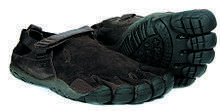
Origin
Invented in 1999 by Robert Fliri, a design student from Vinschgau who wanted to "figure out a way to move around in nature better." Vibram FiveFingers were developed and introduced in 2005.[2][4][5][6][7][8]
Purpose
Vibram FiveFingers were originally targeted to yacht racers to maintain grip on slippery decks without compromising the barefoot experience.[9] Their potential use as a minimalist running shoe was suggested to the Vibram CEO by Ted McDonald, a runner who earned the nickname "Barefoot Ted" for his unshod feet and successful career as a barefoot running coach.[10] The purpose of these shoes as outlined by the manufacturers is to provide footwear to be mainly used for fitness, running, water sports, yoga, trekking and travelling, and other sports.[11]
Design
Styles
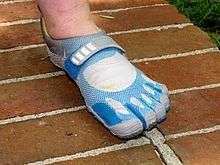
Vibram FiveFingers come in a variety of styles and sizes, including FiveFingers KMD Sport, KMD Sport LS, Classic, Sprint, Flow, KSO (the most popular), TrekSport, KSO Trek, Bikila (named for Abebe Bikila), Bikila LS, Speed and also men's styles FiveFingers Spyridon, Trek LS and Bormio and women's styles FiveFingers Jaya and Jaya LR.[12] Children's KSO, Sprint and Speed styles are available.[13]
Sizing
Unlike traditional footwear, Vibram FiveFingers do not follow the typical US or UK shoe-sizing scales. They require precise foot length measurement with accuracy of 1/8 inch (3 mm) and conversion to the FiveFingers sizing chart. This ranges from 38–50 for men, 34–42 for women, and 29–36 for children. As a result, the shoe sizing more closely mirrors the EU system. However, minor discrepancies exist between the women's and men's sizing, so, e.g., a women's size 39 does not equal a men's size 39.[14]
Materials
Vibram FiveFingers comprise many different materials that vary depending on the style of shoe. The most common components are Vibram TC-1 performance rubber, which makes up the sole of these shoes, a thin stretch polyamide comprising the frame of the shoe that molds to the contours of the user's foot, and an antimicrobial microfiber footbed.
Minimalist shoes
In a report on an article in Nature, co-author Daniel E. Lieberman stated that "People who wear conventional running shoes tend to run with a significantly different strike than those who run in minimalist shoes or barefoot. More specifically, the ball of the foot should strike the ground before the heel when running (or walking) barefoot or in minimalist shoes. By landing on the middle or front of the foot, barefoot runners have almost no impact collision."[15] Lieberman et al.'s study was an experiment that involved five groups of runners from Kenya and the United States. The two American groups were adult athletes who had run with shoes since childhood, and those who habitually ran barefoot or with minimal footwear such as Vibram FiveFingers (mentioned by name in the study). The three Kenyan groups were adults who had never run in shoes until late adolescence, as well as two teenage groups: those that habitually wore shoes and those that always ran barefoot. The runners were instructed to run over a force plate that was embedded in a 25-meter track, and were recorded during the run using a three-dimensional infrared kinematic system. These measurements were used to assess the pattern with which the foot strikes the ground and how forcibly it does so.[16]
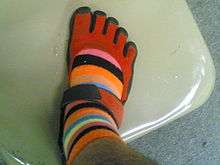
Health effects
Barefoot running, which is similar to running with FiveFingers on, appears to decrease the risk of ankle sprain and plantar fasciitis.[17]
If not conditioned slowly enough, especially when transitioning away from heelstrike running or from wearing shoes with an elevated heel, the sole of the foot or plantar fascia can become inflamed or damaged with activity.[16] Also due to over-training or incorrect form, runners may experience Achilles tendonitis or metatarsal inflammation and fractures. Over-striding in Vibram FiveFingers, that is, landing with the foot too far in front of one's hips, adds extra unnecessary stress to the calf muscles, Achilles tendon, and the arch of the foot, which can lead to serious health problems if not addressed.[16]
One study found a greater number of new wearers of FiveFingers showed an increase in bone marrow edema than those in the study's control group.[18] It recommended transition to use of the shoe be very slow and gradual.
Lawsuit
In 2012, an initial lawsuit was filed against Vibram over claims made about their FiveFingers minimalist shoe. Vibram claimed that the shoe "reduce[s] foot injuries and strengthen[s] foot muscles". While Vibram has "expressly" denied "any actual or potential fault ... or liability", on May 7, 2014 it was announced that company has moved to settle the suit and agreed to set aside $3.75 million to pay refunds of up to $94 to anyone who had purchased the product since March 21, 2009.[3]
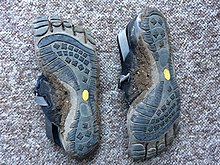
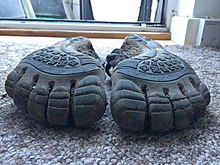
References
- "The Living Barefoot Show episode #3: Interview to Michael Martin, National Sales Manager for Vibram FiveFingers". 2009-07-30. 47 minutes in. Missing or empty
|series=(help) - "Foot mechanics and health". Vibram FiveFingers. 2010-07-20. Retrieved 2011-10-17.
- Lenny Bernstein (May 8, 2014). "People who bought these Vibram FiveFinger shoes may be entitled to a refund". Washington Post. Retrieved May 8, 2014.
- "The story of the five fingers". Bodyconsciousdesign. 2006. Retrieved October 16, 2011.
- Dziernak, Lou (November 2009). "Barefoot your Soul". SGB. doi:1933424561. ISSN 1548-7407.
- "Vibram FiveFingers shoes". Steve van Dulken. 2009. Retrieved October 16, 2011.
- Vonhof, John (2011). Fixing Your Feet: Prevention and Treatments for Athletes. Wilderness press. pp. 85-86. ISBN 978-0-89997-638-9.
- "Bare facts; Running fads". The Economist. September 16, 2011. doi:2458505431.
- "Protect your feet at the beach, in the boat or at the mall with shoes designed for water and land but with more support than a water sock.". Star Tribune. June 20, 2006. doi:1064219291.
- McDougall, Christopher (2009). Born To Run (1st ed.). New York: Vintage Books. pp. 163–164. ISBN 9780307279187.
- "Men's Footwear." www.vibramfivefingers.com. Vibram, n.d. Web. 10 Nov 2011. <"Archived copy". Archived from the original on November 11, 2011. Retrieved November 10, 2011.CS1 maint: archived copy as title (link)>.
- "Women's Footwear." www.vibramfivefingers.com. Vibram, n.d. Web. 10 Nov 2011. <"Archived copy". Archived from the original on November 13, 2011. Retrieved November 10, 2011.CS1 maint: archived copy as title (link)>.
- "Kid's Footwear." www.vibramfivefingers.com. Vibram, n.d. Web. 10 Nov 2011. <http://www.vibramfivefingers.com/products/kids_footwear.htm>.
- "Size Conversion Chart." www.vibramfivefingers.com. Vibram, n.d. Web. 10 Nov 2011. <"Archived copy". Archived from the original on November 15, 2011. Retrieved November 10, 2011.CS1 maint: archived copy as title (link)>.
- "Barefoot running: How humans ran comfortably and safely before the invention of shoes". Sciencedaily.com. 2010-02-01. Retrieved 2011-10-17.
- Lieberman, DE.; Venkadesan, M.; Werbel, WA.; Daoud, AI.; D'Andrea, S.; Davis, IS.; Mang'eni, RO.; Pitsiladis, Y. (Jan 2010). "Foot strike patterns and collision forces in habitually barefoot versus shod runners". Nature. 463 (7280): 531–5. Bibcode:2010Natur.463..531L. doi:10.1038/nature08723. PMID 20111000.
- Warburton, Michael. "Barefoot Running may help keep runners on their feet." Sportscience. (2001): n. page. Web. 10 Nov. 2011. <http://www.sportsci.org/jour/0103/mw.htm>
- http://unique-sportstime.de/site/wp-content/uploads/Barfuss-Laufen1.pdf
External links
| Wikimedia Commons has media related to FiveFingers shoes. |